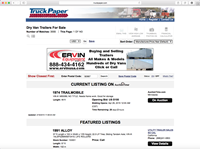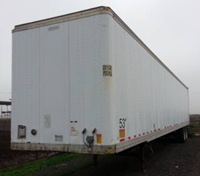 Long before becoming an independent owner-operator, I used to keep an eye on the used truck and trailer sales market. In a way, it was a method for keeping a pulse on what was going on in certain facets of the industry. Now that I am an independent, it is much more important to keep an eye on these things. Being a small time operator, as compared to a major fleet, it is more likely that an increase in my fleet size would come from adding used trailers versus new. Although a new trailer would have certain advantages in reduced maintenance and reliability, the price of trailers due to the current shortage has raised a considerable amount from what it once used to be. It was not until recently, when I analyzed the “ghosts” of trucking’s past, when I realized just what factors were causing this spike in trailer price.
Long before becoming an independent owner-operator, I used to keep an eye on the used truck and trailer sales market. In a way, it was a method for keeping a pulse on what was going on in certain facets of the industry. Now that I am an independent, it is much more important to keep an eye on these things. Being a small time operator, as compared to a major fleet, it is more likely that an increase in my fleet size would come from adding used trailers versus new. Although a new trailer would have certain advantages in reduced maintenance and reliability, the price of trailers due to the current shortage has raised a considerable amount from what it once used to be. It was not until recently, when I analyzed the “ghosts” of trucking’s past, when I realized just what factors were causing this spike in trailer price.
 Looking at buying a used trailer myself this week, I figured it would be an easy task to pick a trailer, contact the bank and then drive it home after an inspection and some registration and purchase paperwork. In doing so, not only was I shocked by the lack of decent dry vans available with model years ranging from 2005-2011, but also I was equally shocked by the premium price that much of this equipment is now going for. I was actually lucky enough to schedule an appointment with one of the dealer’s purchasers and talk with him about the cause and effect of what has led to what seems to be a dry van trailer shortage, which is also threatening to affect other parts of the trucking industry as well.
Looking at buying a used trailer myself this week, I figured it would be an easy task to pick a trailer, contact the bank and then drive it home after an inspection and some registration and purchase paperwork. In doing so, not only was I shocked by the lack of decent dry vans available with model years ranging from 2005-2011, but also I was equally shocked by the premium price that much of this equipment is now going for. I was actually lucky enough to schedule an appointment with one of the dealer’s purchasers and talk with him about the cause and effect of what has led to what seems to be a dry van trailer shortage, which is also threatening to affect other parts of the trucking industry as well.
 During the time leading up to what some call “The Great Recession”, trailer manufacturing companies were producing new trailers at a steady pace. As soon as the recession started to take a firm hold in 2007, trailer manufacturers began to slow their rate of new trailer production, with some cutting production levels down to under 50% of pre-recession rates. This decreased rate of production continued until signs of an economic recovery began to surface near the latter part of 2011 and well into the year 2012. Around that time production levels began to increase, but they were not pumping out trailers nearly as fast as they were in pre-recession times. Now that the economy seems to be getting its head above water, the lack of trailers produced during the economic downturn is creating a shortage for anyone in the market for a used trailer.
During the time leading up to what some call “The Great Recession”, trailer manufacturing companies were producing new trailers at a steady pace. As soon as the recession started to take a firm hold in 2007, trailer manufacturers began to slow their rate of new trailer production, with some cutting production levels down to under 50% of pre-recession rates. This decreased rate of production continued until signs of an economic recovery began to surface near the latter part of 2011 and well into the year 2012. Around that time production levels began to increase, but they were not pumping out trailers nearly as fast as they were in pre-recession times. Now that the economy seems to be getting its head above water, the lack of trailers produced during the economic downturn is creating a shortage for anyone in the market for a used trailer.
 Generally, this would not be a considerable problem to deal with for most buying used trailers. Large fleets have historically had a lot of their used trailers up for grabs at reasonable prices, as they replace their decade old equipment with new trailers. In one flail swoop this “Perfect Storm” has led to a decrease in total used trailer availability, an increase in need as the economy begins to recover and trucking picks up, an inability for trailer manufacturers to keep up with new trailer demand, and a need for large fleets to keep their older trailers and put them back in service to replace the need that used to be filled with new trailer deliveries. This leaves a trucker like me with only a couple options…pony up for a new trailer (only if in stock due to manufacturer backorder), or pay $2000-$3000 more for a used trailer than what it would have cost just six months earlier. With trucking forecasted to reach some record numbers of freight volume this year, could the possibility be out there for even more of a price spike that could spread across other types of trailers as well?
Generally, this would not be a considerable problem to deal with for most buying used trailers. Large fleets have historically had a lot of their used trailers up for grabs at reasonable prices, as they replace their decade old equipment with new trailers. In one flail swoop this “Perfect Storm” has led to a decrease in total used trailer availability, an increase in need as the economy begins to recover and trucking picks up, an inability for trailer manufacturers to keep up with new trailer demand, and a need for large fleets to keep their older trailers and put them back in service to replace the need that used to be filled with new trailer deliveries. This leaves a trucker like me with only a couple options…pony up for a new trailer (only if in stock due to manufacturer backorder), or pay $2000-$3000 more for a used trailer than what it would have cost just six months earlier. With trucking forecasted to reach some record numbers of freight volume this year, could the possibility be out there for even more of a price spike that could spread across other types of trailers as well?